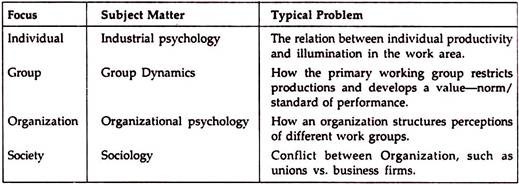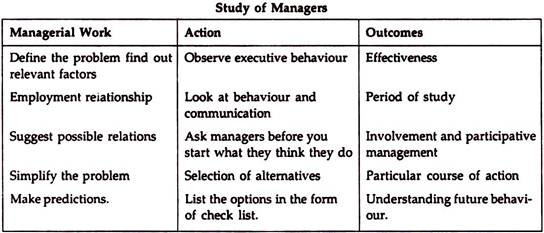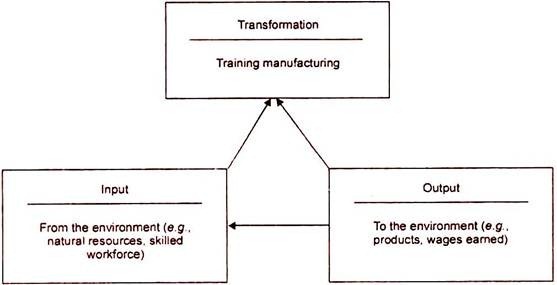Read study notes on Organizational Behaviour. According to Stephen Robbins, “Organizational behaviour is a field of study that investigates the impact of individuals, groups, and structure on behaviour within organizations for the purpose of applying such knowledge toward improving an organization’s effectiveness.”
Organizational Behaviour Notes
Contents:
- Definition and Meaning of Organizational Behaviour Notes
- Subject Matter of Organizational Behaviour Notes
- Importance of Organization Behaviour Notes
- Why Study Organizational Behaviour?
- Dimensional Characterization of Organizational Behaviour Notes
- New Challenges to Organizational Behaviour Managers
# 1. Definition and Meaning of Organizational Behaviour Notes:
Organizational behaviour is a field of study that investigates the impact of individuals, groups, and structure on behaviour within organizations for the purpose of applying such knowledge toward improving an organization’s effectiveness. —Stephen Robbins
“Organizational behaviour is essentially concerned with what people do in organizations”. —Joe Kelly
ADVERTISEMENTS:
But when people are brought together in organization they behave differently. Organizational climate has got peculiar influence on their psychological processes in mind—perception, emotion, and action. So
B = ∫O and O = ∫B
Chris Argyris, in his study, found that chief executives behave in a rather aristocratic manner towards the subordinates. In such context of dependency of the subordinates on boss, they perceive the boss as threatening. In such context of dependency of the subordinates on boss, they perceive the boss as threatening. They feel apprehensive and act accordingly.
The organization is structuring the relationships, processing their behaviour and forming their values. Put it clearly, Organization is the framework of management. (E.F.C. Brech) (framework of perceptions or roles). It is also a process and a set of useful beliefs (values) for a purpose.
ADVERTISEMENTS:
O = ∫B
A good working definition:
“Organizational behaviour is the systematic study of the nature of organizations: how they begin, grow and develop and their effect on individual members’ constituent groups, other organizations and larger institutions.”
# 2. Subject Matter of Organizational Behaviour Notes:
OB includes core topics of motivation, leader behaviour and power, interpersonal communication, group structure and process, learning, attitude development and perception.
Larry L. Cummings attempts to define OB “Toward Organizational Behaviour” as distinguished from other disciplines such as Organizational Theory (OT) Organizational Psychology (OP) and personnel and HRM. According to him, OB is an evolving field which includes human behaviours (based on needs/wants and nature inclinations) contingency or situational factor and other psychological factors.
Further he says that behaviour and organization is based on ‘units of analysis’ i.e., individuals and their interactions, characteristics of organizations (e.g., structure, process, climate). Organizational theory (OT) is typically defined by its focus upon the organization as the unit of analysis. Structure, process, goals technology defined by its focus upon the organization as the unit of analysis. Structure, process, goals technology and climate are relevant dependent variables that vary with environmental changes.
Some have defined OB as studies utilizing behaviour and occasionally field experimentation. Others view OB as field’s mission of adding, describing facts empirically based (How throne plant experiment). Some generalizations have been drawn about OB that would be very helpful in explaining and predicting what people do and will do by observing sensing, asking and listening.
Freud Luthans while discussing about OB refers to conceptual and human side of management and with the application techniques that most experts in productivity are talking about.
# 3. Importance of Organization Behaviour Notes:
ADVERTISEMENTS:
The Importance of OB may be clear, but we should take a few moments to make it even more explicit. Most people are born and educated in organizations, acquire most of their material possessions from organizations, and die as members of organizations.
Many of our activities are regulated by the various organizations that make up our governments. And most adults spend the better part of their lives working in organizations. Because organizations influence our lives so powerfully, we have every reason to be concerned about how and why those organizations function.
In our relationships with organizations, we may adopt anyone of several roles or identities. For example, we can be consumers, employees, or investors. Since most readers of this book are either present or future managers, we will adopt a managerial perspective throughout our discussion.
The study of organizational behaviour can greatly clarify the factors that affect how managers manage. Hence the field attempts to describe the complex-human context of organizations and to define the opportunities, problems, challenges and issues associated with that realm. The value of organizational behaviour is that it isolates important aspects of the manager’s job and offers specific perspectives on the human side of management.
ADVERTISEMENTS:
Clearly then an understanding of OB can play a vital role in managerial work. To use the knowledge provided by this field most effectively, however managers must thoroughly understand its various concepts, assumptions and premises.
# 4. Why Study Organizational Behaviour?
Management is generally considered to have three major dimensions—technical, conceptual, and human. In the past, most practicing managers ignored human dimension of jobs till the Hawthorne plant experiment in General Electric’s Co. Most managers thought and many still do that their employees were basically lazy, that they were interested only in many.
If you could make them happy, they would be productive. Such assumptions were accepted and management tried to solve through various devices such as monetary incentive plans needs satisfaction (Maslow’s needs hierarchy and Douglas’s human side of enterprise).
If proper managerial approach is made to understand their behaviour and accordingly better working conditions and social needs are provided, morale would be high and maximum productivity would result. (Human Relations).
ADVERTISEMENTS:
More and more managers are confronting the challenges of improving productivity in organization and quality of products and services. Towards improving quality and productivity, they are implementing programs like Total Quality Management (TQM) and reengineering— involvement/participation.
Managing work force diversity is to have insight into the behaviour of individual differences and groups solidarity and to assimilate them. Work force diversity means that organizations are becoming more heterogeneous in terms of gender, race and ethnicity. Work force diversity has important implications for management practice.
Managers will need to shift their philosophy from treating everyone alike to recognizing differences and to ensure employee relation and greater productivity.
OB is interdisciplinary in approach i.e., a number of specialists from different fields get together to work on a particular problem.
ADVERTISEMENTS:
OB people hold the following beliefs:
(i) Flat organizations are more effective than tall ones.
(ii) The smaller the span of control, the more effective the leader.
(iii) Horizontal communications are to be preferred to vertical communications.
(iv) Everybody should know everything instantly.
(v) An environment rich in inflammations is best.
ADVERTISEMENTS:
(vi) Informal organizations are superior to formal systems.
(vii) Participation is effective in all circumstances.
(viii) Managers with achievement need are highly effective.
Or Organizational Behaviour as a Creative Science:
These generalizations reflect the creative component in organizational behaviour. OB people have their own preferences. But they ought to check their theories against some solid criteria.
According to Abraham Kaplan, a good theory meets the following criteria or norms:
ADVERTISEMENTS:
Correspondence: It fits the facts.
Coherence: It fits together logically.
Parsimony: It explains the most for the least assumption.
Replacing Intuition with Systematic Study:
Observing and watching the actions of others is human tendency. But interpret it explicitly and attempt to predict what they might do under different condition, is the systematic study.
Consistency and Rational:
ADVERTISEMENTS:
Underlying this systematic approach is the belief that behaviour is not random. It is caused and directed toward some end—individual interest. It is rational because perceived behaviour is intended to gain something.
Certainly there are differences between individuals. Placed in similar situations, all people do not act alike. But some common fundamental consistencies underlie the behaviour of all individuals that can be identified and modified. This is important because they allow predictability. One can predict the driver of a car will stop to see the red signal and drive on the green signal.
Systematic study of behaviour is a means to making accurate predictions. Any systematic study attempts to attribute causes, and effects and draw conclusions based on scientific evidence. Marvin Daunette has devised a six-step plan in inquiry to bring about organizational change.
The steps are:
(i) Observe behaviour of individuals in organizations in their natural settings.
(ii) Detect and measure differences in behaviour against a standard criterion.
ADVERTISEMENTS:
(iii) Speculate and specify the variables of relationships.
(iv) Collect and measure data that illuminate the problem.
(v) Analyze and interpret the data and the process of working through this data to develop models and theories.
(vi) Change the situation with a view to improve effectiveness or human satisfaction.
Focus on Behaviour:
The distinctive feature of organizational behaviour is that it focuses on human behaviour. For example, if one wants to study executives, he could basically do three things. Ask them what they do—interviewing examination of records or study them in action—observation.
# 5. Dimensional Characterization of Organizational Behaviour Notes:
OB is evolving towards the model. Three dimensions define the concept of OB.
OB is a way of thinking manner of conceiving problems and finding solutions. OB’s assertion that behaviour within organization is subject to systematic study and way of thinking to influence methodologies. Secondly, its orientation toward change. Thirdly, OB has got humanistic tone, reflects in personal growth and self-development.
The field of OB includes courage of models, constructs, and facts on: motivation, learning or socialization, group structure and process, task design interpersonal communication etc. OB is also a system or a collection of technologies.
Techniques exist for:
i. Training leaders,
ii. Disguising tasks,
iii. Performances,
iv. Rewarding behaviours.
Factors influences OB lie in environments. In the face of this type of environment, persons must exercise self-control in pursuit of their own objectives. It is their responsibility to fashion themselves to achieve goals, purpose, expectation etc.
Operationalism is reflected in three ways:
i. First, the field is searching for theories and models (motivation, leadership etc.).
ii. Second, emphasis is being given to the operations or behaviours through which people within organizations function.
iii. Third measurement issues are impacting the field.
Finally many assumptions and models in OB are moving toward the direction of leadership motivation theory and especially goal-oriented behaviour.
What are the implications of this perspective on the field? Definitions of the domains of OB, OT, OIP, and OD are relevant in understanding organizational behaviour (figure exhibits) Definitions are needed to guide the field toward operational theory. Definitions established lead to fruitful results. Further, realities in organizations change so rapidly that our descriptions (ways of thinking, constructs, and technologies) do not keep pace with the rate of change in the objects of our study.
Lastly, we are moving toward best labeled organizational analysis or organizational science.
# 6. New Challenges to Organizational Behaviour Managers:
What are the field’s fundamental assumptions? Fundamental ideas that are widely accepted by everyone who does scientific research on OB or who puts these findings into practice in organization.
First OB recognizes that organizations are dynamic and always changing.
Second, the field of OB assumes there is no one single best way to behave in organizations. That is why the OB positions as challenging to the managers practicing in organizational behaviour field.
OB recognizes the dynamic nature of organizations. So the OB managers/practitioners, are confronted with the problems of intractable, unpredictable nature and behaviour of people in the organization. The challenges came in the form of the questions—under what conditions will organizations change? How are organizations structured? How do organizations interact with their environments?
These and related questions are of major interest to specialists in OB. They view organizations as open system. The open systems approach is characteristic of modern day thinking in the field of OB. Organizations transform inputs to outputs in a continuous fashion.
Open System:
Self-sustaining systems that transform input from the external environment into output which the system then returns to the environment.
OB assumes there is no ‘one best’ approach—what’s the most effective way to motivate people? What style of leadership works best? Who should make organizational decision.
Contingency Approach:
An orientation that recognizes that behaviour in work settings is the complex result of many interacting forces. For example, how an individual’s personal characteristics (e.g., personal attitudes and beliefs) in conjunction with situational factors (e.g., an organizational climate, relations between co-workers) all work together. Manager should study behaviour contingent upon certain conditions.
The conditions are as follows:
1. Managers are supported to have clear concepts of productivity and efficiency learnt from scientific management and Hawthorne studies. The scientific management contributed Time and motion study—a type of applied research designed to streamline the individual movements needed to perform jobs with the intent of finding “the one best way to perform them”.
Secondly managers should have human relations skills besides conceptual and technical skills. A perspective on OB—the importance of social process in work settings, which manager in each level should know. Hawthorne studies substantiates that social affiliation increases productivity and efficiency, even if there is change in working condition and wage/salary of the workers.
This concludes that managers should know group dynamics as a new way of thinking about behaviour at work.
2. The emphasis on human skills was considered important in the post but it is of primary importance today. It is generally agreed that at least three areas of skill are necessary for the process of management; technical, human and conceptual.
Human Skill—ability and judgement in working with and through people, including an understanding of motivation .and an application of effective leadership.
The leadership and management of organizations have never been more challenging and this is an exciting period for understanding and practicing both. The challenging problems in the management are business (profit organizations) government, not-for-profit, etc., and society. The real test of managerial effectiveness lies in leadership, to know domestic and internationals events.
The pace of change will continue to accelerate. The major challenge management faces today is living in a world of turbulence and uncertainty where the new competitors arrive on the scene.
3. The domain of management has become worldwide. Michall Porter, well-known author is strategic management expressed this idea of change in an international dimensions. Leaders/managers must meet this challenges, to serve demanding needs and above all to keep progressing.
The dissemination of information has exploded—today in this info-tech age computer technology has made it possible to eliminate vast amount of learning, monotonous physical labour. So modern technology has changed the way managers operate. Today, however, easy access to information in computer databases has made it possible to gather the facts. The best managers should learn this technology to tap employees and build relationships.
4. Contemporary OB recognizes that people care more than ever about the interpersonal side of work—recognition, relationships and social interaction. This is more challenging, meaningful and interesting to connect these to various economic social and cultural trends and forces that shape today’s society.
These include three prominent trends:
(i) The rise of global business
(ii) Rapid advances in technology and
(iii) The rising expectations of people in general.
The New World Order is Emerging:
Shift from human warfare to human welfare is emerging. For example GATT (General Agreement on Tariffs and Trade) and NATFA (North American Free Trade Agreement) are just a few of the new trade arrangements that are becoming more powerful than military alliances. Tomorrow successful leaders will focus on action and implementation leadership, change, implementation, results: these are the operative words for the new world order.
To Build Competitive Advantage:
It is the capability of the manager to build competitive advantage by applying industrial engineering techniques such as methods analysis, workflow, etc.. But the challenges come through better use of human resource management.
Capability of Effective Organizations:
Customer satisfaction, respond quality and customer satisfaction, respond quickly to environmental changes, and innovate. To achieve these, every manager must face as challenges and are committed to continuous learning.
The challenges of leading an organization—some concepts in the behavioral science give some good ideas to think about but they do not always tell you how or when to put those ideas into practice in the management.
Leadership and management are full time responsibilities that must be practiced every hour of every day. Situational leadership provides such a common language to help solve performance problems. Managers of OB are in pursuit of goal accomplishment, readiness assessment, appraisal of the results, to cope up the challenges they confront.



